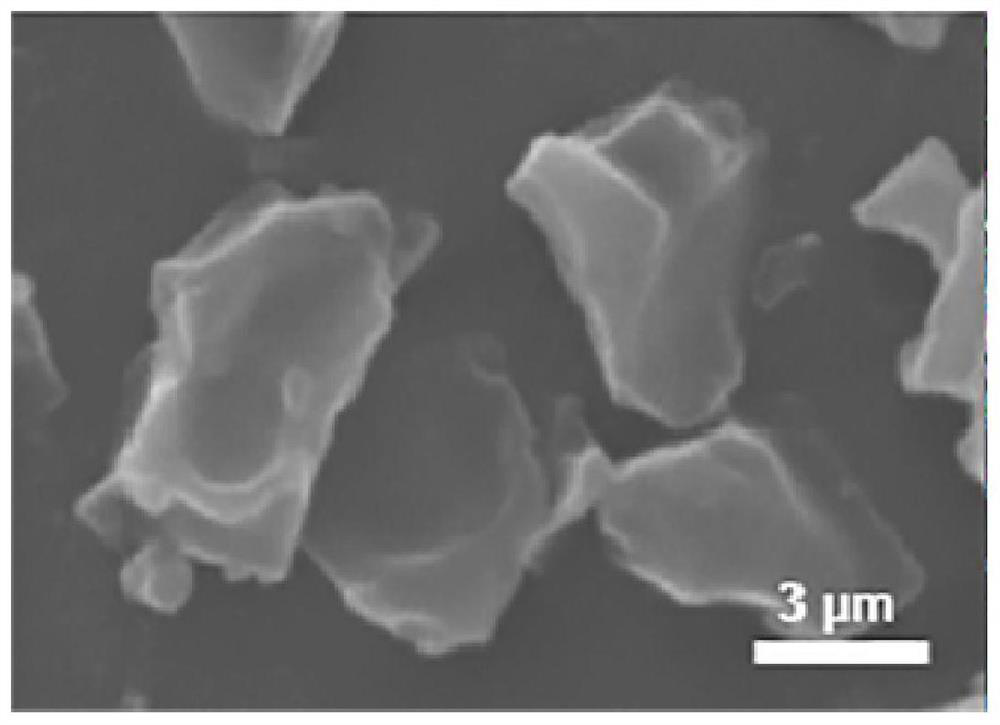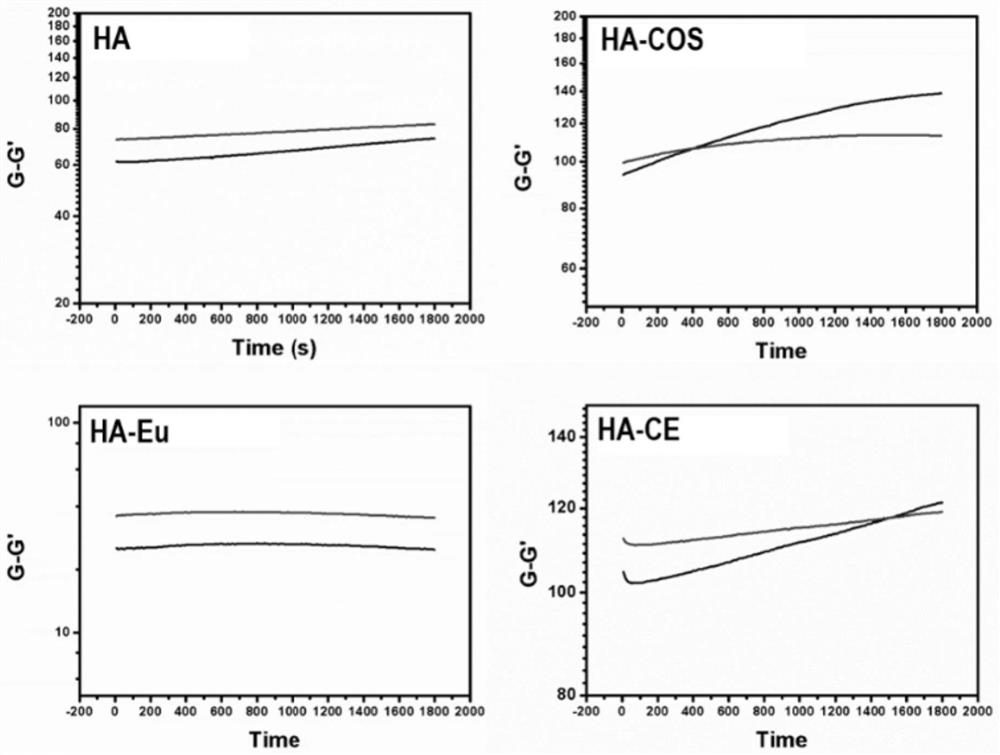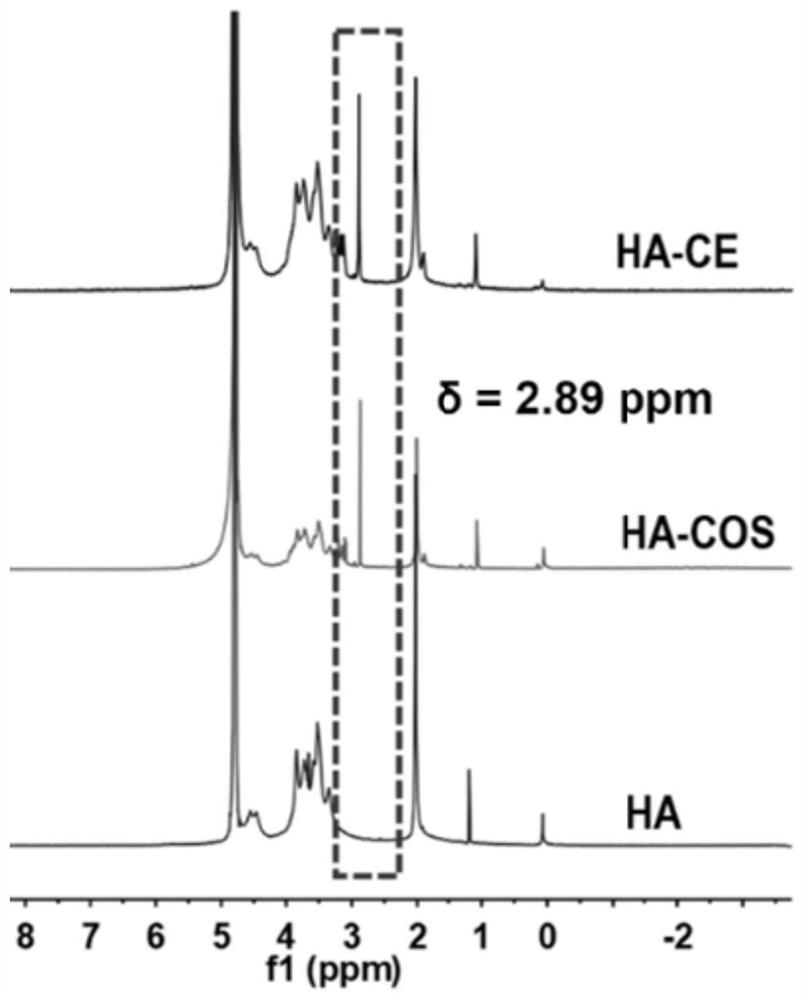Functional sponge for promoting wound healing and reducing wound scar formation and preparation method and application thereof
A functional, sponge technology, applied in the field of biomedical engineering, can solve the problems of scars, scarless healing, scars without effective treatment and intervention methods, etc., to achieve high water absorption, reduce fibrosis, and low cost effects
- Summary
- Abstract
- Description
- Claims
- Application Information
AI Technical Summary
Problems solved by technology
Method used
Image
Examples
Embodiment 1
[0055] Example 1: Optimization of the preparation process of HA-CE sponge
[0056] 1. Preparation of COS-Eu complexes:
[0057] First, 1.2 g of COS was completely dissolved in 100 mL of deionized water. The pH of the COS solution was adjusted to 5.5 with 1M hydrochloric acid. Put Eu (NO 3 ) 3 Stir continuously with the above COS solution. The obtained samples were collected by high-speed centrifugation at 10,000 rpm, frozen in liquid nitrogen, and then transferred to a freeze dryer for vacuum drying to obtain COS-Eu complexes.
[0058] Among them, Eu(NO 3 ) 3 The addition amount of the solution was calculated according to its final concentration in the system as 0.01mol / L, 0.02mol / L and 0.03mol / L, respectively, the reaction temperature was set to 25, 50, 70 and 100°C, and the stirring time was set to 5 and 24h. According to the yield and SEM morphology of the obtained samples, the final sample preparation conditions were selected as 0.01 mol / L and continuous stirring at...
Embodiment 2
[0062] Example 2: Preparation and characterization of HA-CE sponge
[0063] Step (1) Preparation of COS-Eu complex:
[0064] First, 1.2 g of COS was completely dissolved in 100 mL of deionized water. The pH of the COS solution was adjusted to 5.5 with 1M hydrochloric acid. 0.01mol / L Eu(NO 3 ) 3 Stir continuously with the above COS solution at 50 °C for 5 h. The obtained samples were collected, frozen with liquid nitrogen, and then freeze-dried to obtain the COS-Eu complex.
[0065] Step (2) Preparation of HA-CE sponge:
[0066] Weigh 3 g of hyaluronic acid and dissolve it in 100 mL of deionized water with pH=5, and stir with a stirrer at low speed for 24 h to prepare a hyaluronic acid solution. EDC and NHS with a final concentration of 50 mmol / L were added, respectively, and the reaction was stirred at room temperature in the dark for 15 min to activate the carboxyl group of hyaluronic acid. Then, 1.0 g of COS-Eu complex was added to the reaction system, and the reactio...
Embodiment 3
[0083] Example 3: Performance analysis of HA-CE sponge
[0084] 1. Analysis of antioxidant properties of HA-CE sponge
[0085] 1,1-Diphenyl-2-picrylhydrazine radical (DPPH) is widely used in the quantitative determination of the antioxidant capacity of samples. The DPPH radical has a single electron and has a strong absorption at 517nm, and its alcohol solution is purple. When there is a free radical scavenger, its absorption gradually disappears due to its single electron pairing, and the lighter the color, the lower the absorbance value.
[0086] The sponge was added to the DPPH solution (0.1 mM, 4 mL, using methanol as solvent), and after shaking in the dark for 30 min, the color changes in each group were recorded by photographing, and the supernatant was collected and transferred to a glass cuvette. The absorbance of the sample supernatant at 517 nm was recorded using a UV spectrophotometer, and each group of samples was tested 3 times. Finally, the DPPH scavenging rate...
PUM
| Property | Measurement | Unit |
|---|---|---|
| Diameter | aaaaa | aaaaa |
| Average molecular weight | aaaaa | aaaaa |
Abstract
Description
Claims
Application Information
 Login to View More
Login to View More - R&D
- Intellectual Property
- Life Sciences
- Materials
- Tech Scout
- Unparalleled Data Quality
- Higher Quality Content
- 60% Fewer Hallucinations
Browse by: Latest US Patents, China's latest patents, Technical Efficacy Thesaurus, Application Domain, Technology Topic, Popular Technical Reports.
© 2025 PatSnap. All rights reserved.Legal|Privacy policy|Modern Slavery Act Transparency Statement|Sitemap|About US| Contact US: help@patsnap.com



